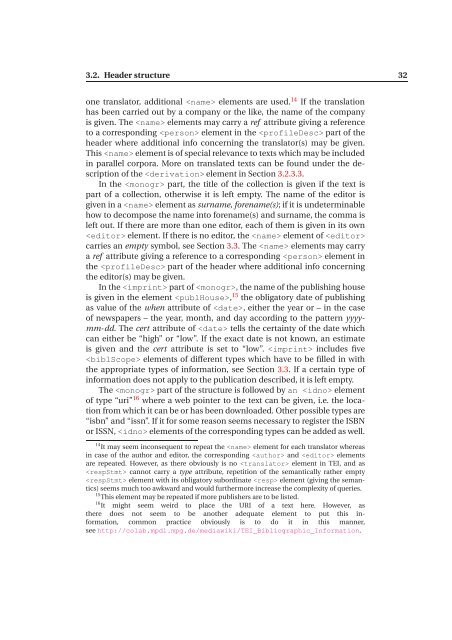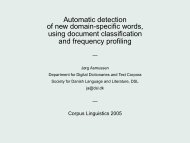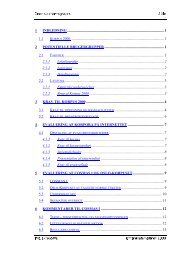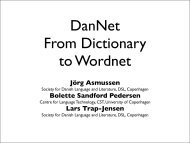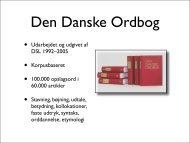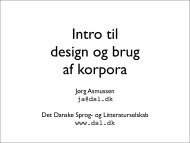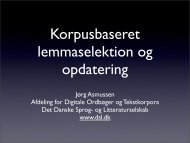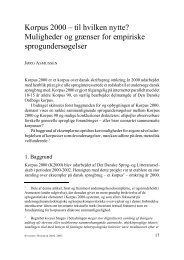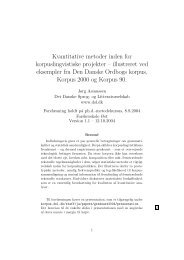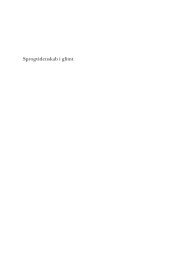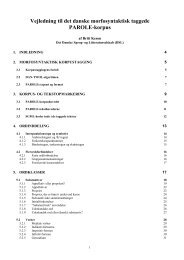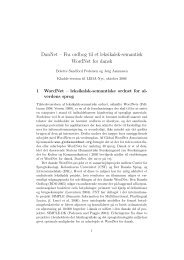The Corpus Thread - Det Danske Sprog- og Litteraturselskab
The Corpus Thread - Det Danske Sprog- og Litteraturselskab
The Corpus Thread - Det Danske Sprog- og Litteraturselskab
You also want an ePaper? Increase the reach of your titles
YUMPU automatically turns print PDFs into web optimized ePapers that Google loves.
3.2. Header structure 32<br />
one translator, additional elements are used. 14 If the translation<br />
has been carried out by a company or the like, the name of the company<br />
is given. <strong>The</strong> elements may carry a ref attribute giving a reference<br />
to a corresponding element in the part of the<br />
header where additional info concerning the translator(s) may be given.<br />
This element is of special relevance to texts which may be included<br />
in parallel corpora. More on translated texts can be found under the description<br />
of the element in Section 3.2.3.3.<br />
In the part, the title of the collection is given if the text is<br />
part of a collection, otherwise it is left empty. <strong>The</strong> name of the editor is<br />
given in a element as surname, forename(s); if it is undeterminable<br />
how to decompose the name into forename(s) and surname, the comma is<br />
left out. If there are more than one editor, each of them is given in its own<br />
element. If there is no editor, the element of<br />
carries an empty symbol, see Section 3.3. <strong>The</strong> elements may carry<br />
a ref attribute giving a reference to a corresponding element in<br />
the part of the header where additional info concerning<br />
the editor(s) may be given.<br />
In the part of, the name of the publishing house<br />
is given in the element, 15 the obligatory date of publishing<br />
as value of the when attribute of , either the year or – in the case<br />
of newspapers – the year, month, and day according to the pattern yyyymm-dd.<br />
<strong>The</strong> cert attribute of tells the certainty of the date which<br />
can either be “high” or “low”. If the exact date is not known, an estimate<br />
is given and the cert attribute is set to “low”. includes five<br />
elements of different types which have to be filled in with<br />
the appropriate types of information, see Section 3.3. If a certain type of<br />
information does not apply to the publication described, it is left empty.<br />
<strong>The</strong> part of the structure is followed byan element<br />
of type “uri” 16 where a web pointer to the text can be given, i.e. the location<br />
from which it can be or has been downloaded. Other possible types are<br />
“isbn” and “issn”. If it for some reason seems necessary to register the ISBN<br />
or ISSN, elements of the corresponding types can be added as well.<br />
14 It may seem inconsequent to repeat the element for each translator whereas<br />
in case of the author and editor, the corresponding and elements<br />
are repeated. However, as there obviously is no element in TEI, and as<br />
cannot carry a type attribute, repetition of the semantically rather empty<br />
element with its obligatory subordinate element (giving the semantics)<br />
seems much too awkward and would furthermore increase the complexity of queries.<br />
15 This element may be repeated if more publishers are to be listed.<br />
16 It might seem weird to place the URI of a text here. However, as<br />
there does not seem to be another adequate element to put this information,<br />
common practice obviously is to do it in this manner,<br />
seehttp://colab.mpdl.mpg.de/mediawiki/TEI_Bibli<strong>og</strong>raphic_Information.


